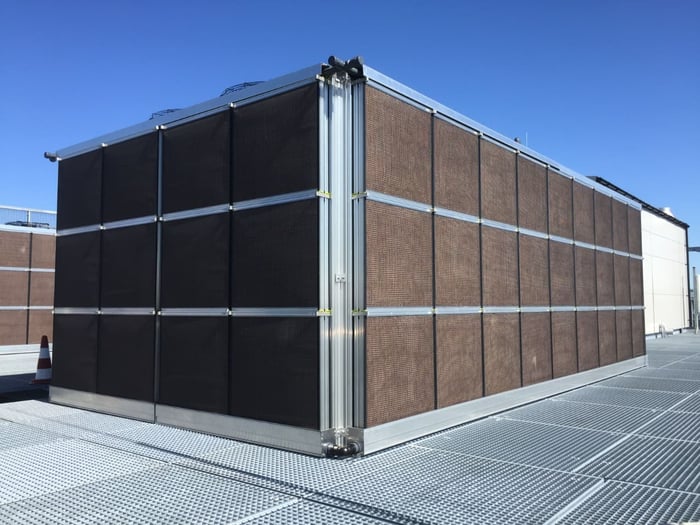High outside temperatures often cause chillers to malfunction and fail to deliver the required cooling capacity. This issue is solved by installing a pre-cooler before the chiller, and the machine can continue to perform even in higher temperatures. This type of pre-cooler comes in all shapes and sizes for all types of chillers. For instance, adiabatic pre-cooling can be used to make industrial air-cooled chillers run more efficiently. Adiabatic pre-cooling ensures that the air is cooled via water evaporation before it enters the chiller. But there are also different types of adiabatic pre-cooling. This blog outlines the pros and cons of two different types: adiabatic pre-cooling with a contact humidifier versus adiabatic pre-cooling with a misting system.
What's the difference between a contact humidifier and a misting system?
Before we get into the pros and cons of adiabatic pre-cooling with a contact humidifier or a misting system, it's essential to understand the exact difference between the two.
Adiabatic pre-cooling with a contact humidifier uses direct evaporation media - a pad. This means that when warm outside air flows through the evaporative media, the water evaporates and cools the air.
Adiabatic pre-cooling with a misting system works slightly differently. Water is atomized under high pressure into the warm supply air, causing it to cool down.
Hygiene and Legionella with adiabatic pre-cooling
Because adiabatic (pre-) cooling uses water in the cooling process, people are often concerned about hygiene, especially legionella. Although systems with a contact humidifier or a misting system can both (usually) be installed with a UV water sterilizer, adiabatic cooling via a misting system definitely carries a legionella risk. The UV treatment minimizes this risk during operation. Still, suppose small portions of stagnant water remain in the pipes, tubes, or pumps in a warm environment when the system is OFF. In that case, legionella can quickly develop and become airborne in the form of aerosols when the system is reactivated. People can contract Legionnaires' disease or Pontiac fever when they inhale tiny water droplets (aerosols) in the air that contain the Legionella bacteria. Therefore, manufacturers of pre-cooling with misting systems recommend that these systems not be placed in the immediate vicinity of air handling systems.
Adiabatic pre-cooling with a contact humidifier, on the other hand, eliminates the risk of legionella spreading. Because the water in contact humidifiers is not atomized but evaporated, no (contaminated) aerosols are released into the air. Therefore, systems with a contact humidifier can also be safely placed in the direct vicinity of air treatment systems without additional measures.
Adiabatic pre-cooling in all types of weather
The performance of a misting pre-cooler is affected by wind. At relatively low wind speeds, the mist may be carried away, limiting the efficiency of the pre-cooler. As a result, the indicated theoretical performance of the system will then be strongly reduced. When the misting system sprays against the wind direction, the aerosols stick together, form larger droplets, and fall like rain. In addition, of course, the wind also brings dust with it. This dust clogs the filters used in misting systems, increasing the chance of pressure loss and reducing efficiency. Regular cleaning of the filter during the season is also a requirement, often accompanied by maintenance contracts.
The performance of adiabatic pre-cooling with a contact humidifier, on the other hand, is not affected by wind because the wind has no impact on the evaporation media. And although the wind does, of course, still bring dust that collects on the wet media, there is no chance of clogging. The dust on the evaporation pad is washed away and disposed of by the system when the water is changed. In addition, the wet walls of the evaporation media also provide protection from dust. In effect, the evaporation media acts as an air filter.
Overall performance of adiabatic pre-cooling
Both pre-coolers with a contact humidifier and those with a misting system offer around 90% effectiveness. Yet, there are points, as mentioned earlier, where the pre-cooler with a contact humidifier comes out better than a misting system.
As mentioned above, the outdoor environment - wind and dust - does not affect systems with a contact humidifier. There is also no chance of "dry-spots" (leaving the air partially uncooled) because the pad's entire surface is humidified. In addition, with a contact humidifier, there is no risk of oversaturation or undersaturation due to the influence of wind.
Adiabatic pre-cooling from Oxycom - the PreCooll
In addition to supplying two-stage adiabatic cooling to cool industrial buildings, Oxycom also provides adiabatic pre-cooling for chillers with a contact humidifier - the PreCooll. Apart from the points mentioned above, the PreCooll has many more advantages.
The PreCooll is built around (the condensers of) the chiller and ensures no direct sunlight shines on the components and completely shades the chiller. The PreCooll creates a cool microclimate around the cooling machine, which drastically reduces the heat stress on the components. In addition, the PreCooll is controlled by energy-saving software that takes into account, for example, local weather data and the local water quality. This way, adjustments are made automatically so that the chiller runs as efficiently as possible at the lowest possible energy costs. But perhaps the most important thing: with the PreCooll, you are always assured of the optimal operation of your chiller.
The success of the PreCooll
When the municipality of Amsterdam placed restrictions on power consumption during the construction of Equinix's new data center, the company looked for a solution to make their demanding cooling machines run more efficiently.
By installing the PreCooll, Equinix manages to save up to 40% in energy. Download their case study and read the whole story:

To learn more about Oxycom's pre-cooling. Go to the PreCooll page or contact us directly by filling out the form below.


